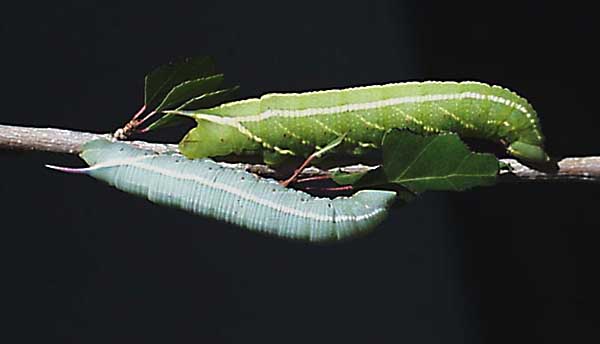Sphinginae subfamily
Sphingini tribe:
 |
Larvae feed on plants in the Convolvulaceae family, especially
Ipomoea batatas (sweet potato) and in the Solanaceae family,
especially (Datura) (jimsonweed) and related plants in the
Americas. There is also a brown form. Look for very large, dark
spiracular circles.
|

|
The caterpillars are called Tomato Hornworms and each has a black horn at the end of the abdomen.
Larvae feed on potato, tobacco, tomato, and other plants in the
nightshade family (Solanaceae). There is also a very beautiful brown form. See bottom of page.
|
 |
Note the green horn, raised white bumps and strong dark lines
anterior to the white ones.
|
 |
Manduca sexta
BAMONA, the Carolina Sphinx
Tobacco Hornworms, equipped with a red-tipped horn at the end of the
abdomen, are true gluttons and feed on tobacco and tomato, and
occasionally potato and pepper crops and other plants in the
nightshade family (Solanaceae).
|
 |
Sphinx chersis
BAMONA, the Great Ash Sphinx
The larvae are pale bluish green. The head has a pair of yellow
lateral bands meeting at the apex.
Larval hosts are ash, lilac, privet, cherry, and quaking aspen.
|
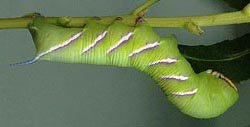 |
Sphinx perelegans
BAMONA, the Elegant Sphinx;
A unique feature of this larva is a shield on the first thoracic
segment, which is of the same colour as the body and which forms a
tight-fitting hood over the vertex of the head. This hides a pair of
glossy black spots on top of the head, which are revealed if the
animal is disturbed.
|
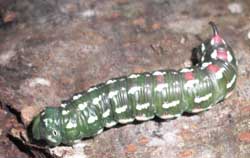 |
Larvae feed on California juniper (Juniperus californica) and Rocky Mountain juniper (J. osteosperma).
|
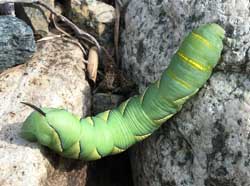 | Larvae feed on the common snowberry (Symphoricarpos albus)
and on coralberry (S. orbiculatus). Note the two golden lines
of slightly raised bumps, one just behind the head, the other on the thorax.
generally more easterly
|
Smerinthini Tribe:
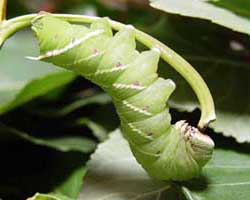 |
Larvae feed on cottonwood and poplar (Populus) and willow
(Salix).
Larvae are very chunky with little to distinguish them
from Pachysphinx modesta.
|
 |
Smerinthus cerisyi
BAMONA,
Cerisy's Sphinx;
Cerisyi larvae greatly resemble modesta larvae, both being pale
green, with granular skin, pale lateral diagonal lines, faint red
spiracular circles, and very pale longitudinal lines running from the
head to a more pronounced anal diagonal line.
Larvae have green heads bounded dorsally with a pale yellow
inverted "V".
|
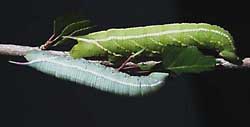 |
Smerinthus saliceti
MCL/BAMONA,
Salicet Sphinx;
Saliceti larvae greatly resemble cerisyi larvae, both being pale
green or blue, with granular skin, pale lateral diagonal lines, faint red
spiracular circles, but saliceti have a pronounced longitudinal line running from the
head to a more pronounced anal diagonal line.
Larvae have green heads bounded dorsally with a pale yellow
inverted "V".
|
Smerinthus saliceti adult moth, Riverside, September 14, 2011, Michelle Campbell-LaRock
Macroglossinae subfamily
Dilophonotini Tribe:
Aellopos clavipes BAMONA, might occur as a rare stray adult moth, but it is not believed there are breeding populations in California.
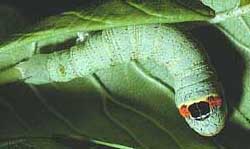 |
This species is more likely to occur as an occasional stray rather than as a breeding resident.
As a migrant stray it would be seen later in the season, July-August. |
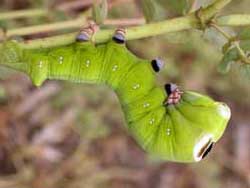 |
Larvae feed on papaya (Carica papaya), Cnidoscolus
angustidens, poinsettia (Euphorbia pulcherrima),
guava (Psidium species) and
saffron plum (Bumelia angustifolia/Bumelia celastrina).
Manilkara bahamensis,
Willow Bustic (Bumelia salicifolia)
and Painted Leaf (Poinsettia heterophylla) are also hosts.
Nice socks! Larvae show considerable variation.
|
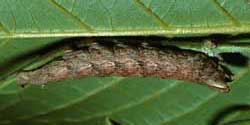 |
Erinnyis obscura, the Obscure Sphinx,
BAMONA.
Larvae probably feed on various plants in the dogbane family
(Apocynaceae): Rauvolfia ligustrina, Rauvolfia tetraphylla,
Stemmadenia obovata, Philibertia, Cynanchum, and on papaya
(Carica papaya, Caricaceae), and Asclepiadaceae.
|
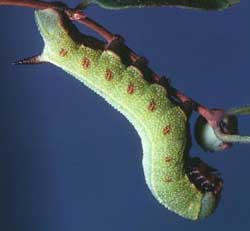 |
Larval host plants include Snowberry (Symphoricarpos),
honeysuckle (Lonicera), Coralberry, viburnums, high bush cranberry and hawthorn (Crataegus).
Horn is black with a slightly lighter base. This western species was formerly classified as
H. diffinis or H. senta. Those species west of the Continental Divide are now classified as
H. thetis.
|
Philampelini Tribe:
 |
Larvae feed upon Grape (Vitis), Virginia Creeper
(Parthenocissus quinquefolia) and other vines and ivies
(Ampelopsis).
Larvae occur in both a light (green) form and a darker (tan/brown)
form. Note six "segmented" oblique lines.
|
Macroglossini Tribe:
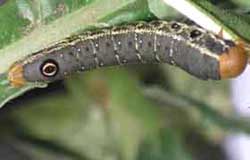 |
Arctonotus lucidus
BAMONA,
the Pacific Green
Sphinx Moth or Bear SphinxLarvae feed on evening primrose
(Oenothera dentata var. campestris) and clarkias. David Wikle
fed them on both Mexican evening primrose, Oenothera berlandieri
and evening primrose, Oenothera biennis. |
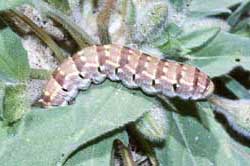 |
Larvae feed on various plants in the primrose family (Onagraceae).
|
 |
Hyles lineata
BAMONA, the White-lined Sphinx
Larvae are highly varied and feed on a great diversity of plants
including willow weed (Epilobium), four o'clock (Mirabilis),
apple (Malus), evening primrose (Oenothera), elm
(Ulmus), grape (Vitis), tomato (Lycopersicon),
purslane (Portulaca), and Fuschia.
All larvae seem, however, to have the red/black swellings split by
dorso-lateral lines. |
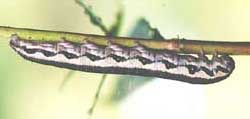 |
Larvae feed on elegant fairyfan (Clarkia unguiculata) in the evening primrose family (Onagraceae). |
|
|
